The Bo Diddley strum is named after Bo Diddley. Bo Diddley is an American R&B vocalist, guitarist, songwriter ( usually as Ellas McDaniel ), and rock and roll pioneer. He introduced more insistent, driving rhythms and a hard-edged electric guitar sound on a wide-ranging catalog of songs, along with African rhythms and a signature beat (a simple five-accent clave rhythm) that remains a cornerstone of rock and pop.
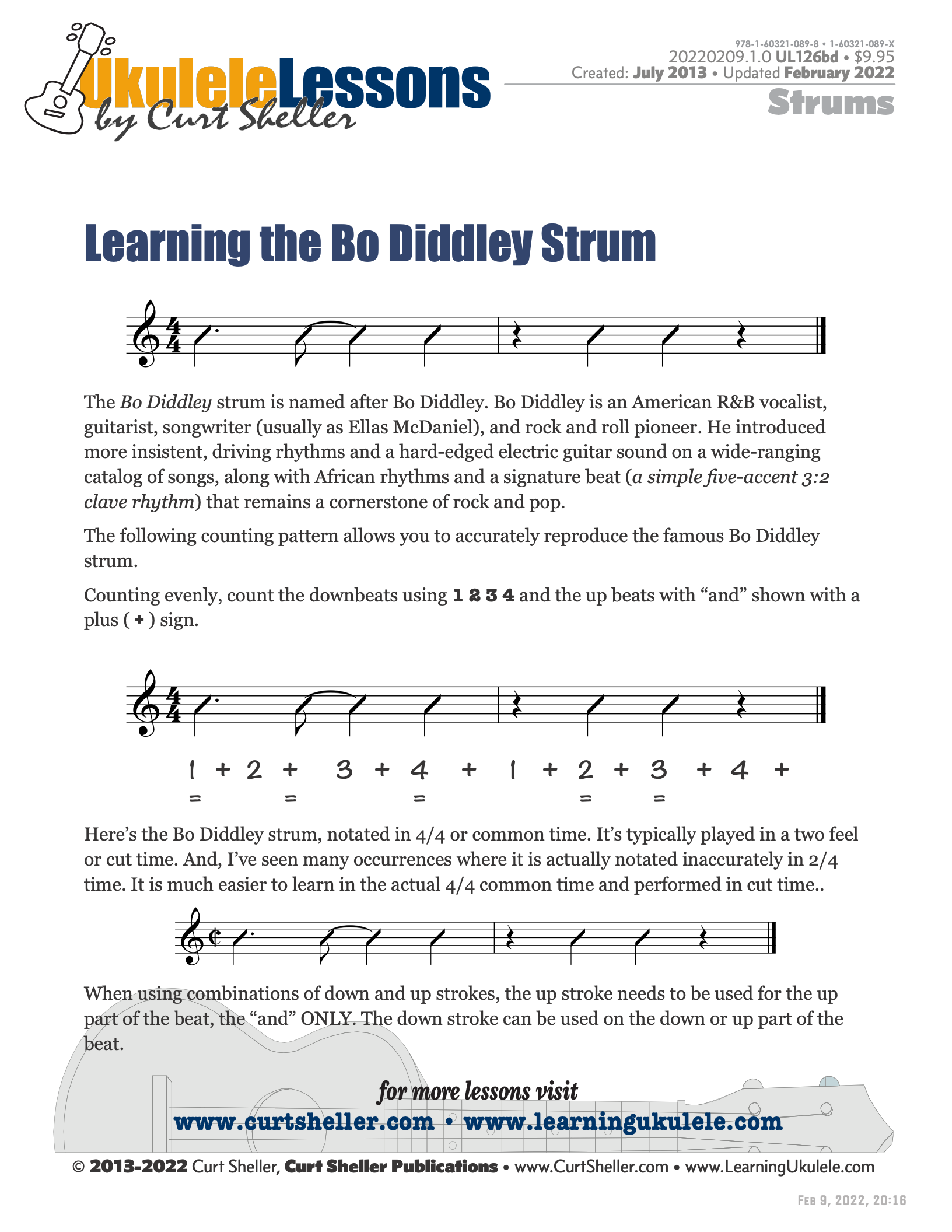
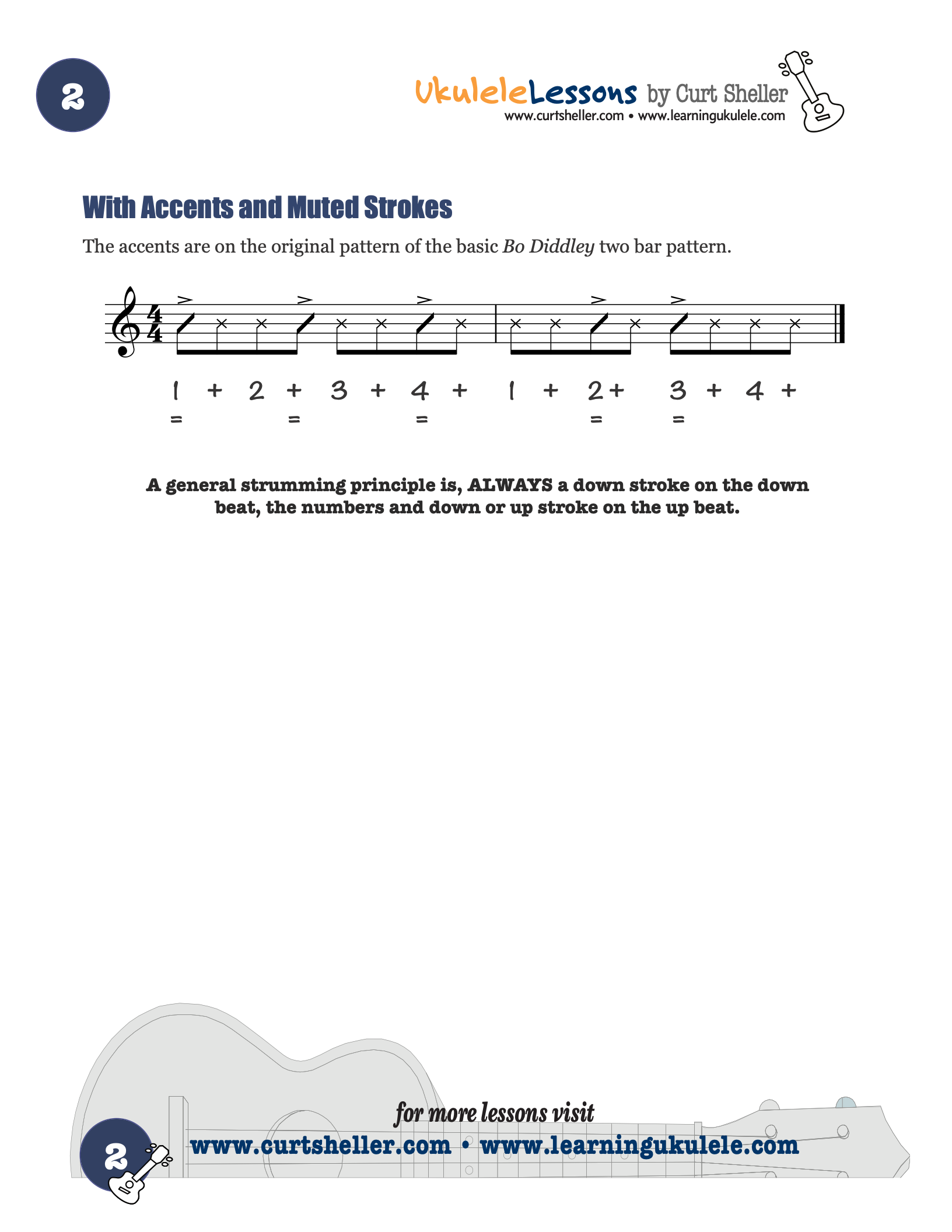


The Bo Diddley strum is named after Bo Diddley. Bo Diddley is an American R&B vocalist, guitarist, songwriter ( usually as Ellas McDaniel ), and rock and roll pioneer. He introduced more insistent, driving rhythms and a hard-edged electric guitar sound on a wide-ranging catalog of songs, along with African rhythms and a signature beat (a simple five-accent clave rhythm) that remains a cornerstone of rock and pop.
This pattern can be played in cut time but should be learned in common time. It is often notated in cut time, making if a bit harder for beginner and intermediate player to learn.
Available for Premium Site Access Plans Only
Clave
The Bo Diddley pattern is a 3:2 Clave. A Clave is a latin rhythm, typically two bars or measures with the accent on three of the attacks in bar one and two of the attacks i bar 2. One of the most famous the the 3:2 clave of a Boss Nova (Brazilian Clave) pattern (shown below).

The 3:2 Clave Pattern
(from WikipediA) The clave (/ˈklɑːveɪ, kleɪv/; Spanish: [ˈklaβe]) is a rhythmic pattern used as a tool for temporal organization in Cuban music. In Spanish, clave literally means key, clef, code, or keystone. It is present in a variety of genres such as Abakuá music, rumba, conga, son, mambo, salsa, songo, timba and Afro-Cuban jazz. The five-stroke clave pattern represents the structural core of many Cuban rhythms.
There are three branches of Clave Theory and WikipediA is a great place to get more information.
Claves are also an actually percussion instrument.
The Bo Diddley strum is named after Bo Diddley. Bo Diddley is an American R&B vocalist, guitarist, songwriter ( usually as Ellas McDaniel ), and rock and roll pioneer. He introduced more insistent, driving rhythms and a hard-edged electric guitar sound on a wide-ranging catalog of songs, along with African rhythms and a signature beat (a simple five-accent clave rhythm) that remains a cornerstone of rock and pop.
This pattern can be played in cut time but should be learned in common time. It is often notated in cut time, making if a bit harder for beginner and intermediate player to learn.
Available for Premium Site Access Plans Only
Clave
The Bo Diddley pattern is a 3:2 Clave. A Clave is a latin rhythm, typically two bars or measures with the accent on three of the attacks in bar one and two of the attacks i bar 2. One of the most famous the the 3:2 clave of a Boss Nova (Brazilian Clave) pattern (shown below).

The 3:2 Clave Pattern
(from WikipediA) The clave (/ˈklɑːveɪ, kleɪv/; Spanish: [ˈklaβe]) is a rhythmic pattern used as a tool for temporal organization in Cuban music. In Spanish, clave literally means key, clef, code, or keystone. It is present in a variety of genres such as Abakuá music, rumba, conga, son, mambo, salsa, songo, timba and Afro-Cuban jazz. The five-stroke clave pattern represents the structural core of many Cuban rhythms.
There are three branches of Clave Theory and WikipediA is a great place to get more information.
Claves are also an actually percussion instrument.
Learning the Bo Diddley Strum
NOTE: Clave patterns are in four (4). However the Bo Diddly strum is felt in 2, cut-time and often written as if it is in 2 using a combination of sixteenth and eight notes. This is the same issue with musicians nor realizing that Cut Time is NOT 2/4. I find the pattern written in 4 to be far easier to notate, remember, read, perform, and teach then in 2.
The most common Cuban clave is the son clave and it is written in 2/4.
There is a very subtle variation between the Bo Diddley pattern and the Bossa Nova pattern.
Famous Songs with the Bo Diddley Beat
In addition to Bo Diddley's namesake song, Bo Diddley, here are a few others songs that use the Bo Diddley beat or variations.
- Not Fade away – THE ROLLING STONES
- Magic Bus – THE WHO
- (Marie’s the Name) His Latest Flame – ELVIS PRESLEY
- Willie and the Hand JIve – THE JOHNNY OTIS SHOW
- Shame, Shame, Shame – SHIRLEY & COMPANY
- She's The One – BRUCE SPRINGSTEEN
- I Want Candy – BOW WOW WOW
- Mr. Brownstone – GUNS N’ ROSES
- Faith – GEORGE MICHAEL
- Desire – U2
A Note Regarding Learning Strums and Rhythm
Many people fall into the trap of mixing up play by ear with learning by ear. Learning by ear is a hit and miss, hunt and peck proposition with more misses than hits.
The goal is to play and perform with the inner ear in control - that is “Playing by Ear”. Learning is better suited with a system and plan of attack.
I've seen it way too many times with my own private students. They insist on trying to learn a specific strumming pattern by their intrinsic stroke directional pattern — the down and up pattern. For only the basic, simplest of strums this might work at times. But, it falls apart for really learning rhythm, which is directly linked to strumming. It is helpful when training the strumming hand to place to emphasis on the downbeats or pulse of music with a down stoke.
Cutting to the Chase — You CAN learn any rhythmic pattern by it's standard music notation and the counting pattern used to recreate the sound of the pattern. What this does is allows you a method to accurately reproduce any pattern on demand — no need to resort to hearing it first. You hear it first with you inner ear and you hands are trained enough to reproduce it on demand. Eyes -> Ear -> Hands.
Personal Quarter Note Triplet
Anecdote
For years, early in my development I had several teachers that tried to teach me the quarter note triple rhythmic pattern by rote. I'd get it in the lesson and 20 minutes after the lesson - at home I wouldn't be able to duplicate what I had learned in the lesson. No fault of the teacher, they just didn't have a system for effectively teaching rhythm and give their students the ability to accurately reproduce any rhythmic pattern on their own without needing a teacher or coach or to even have to hear it first.
Then finally studying with Chuck Anderson, the creator of the Modular Phonetic Rhythm System I now use. In 30 seconds I could play the quarter note triplet and more importantly reproduce it myself — on-demand when needed. Plus even teach it to others. It's all based on learning any rhythmic pattern by knowing how it relates to the beat and the subdivision of the beat. It's actually that simple. The hard part is getting the hands and fingers to get with the show.
I guarantee, that by using this system – you, Will have success.
Related Lessons, Videos, Lesson Series, Songs, Books & Reference Charts, Resources & Assets, Workshops are below.
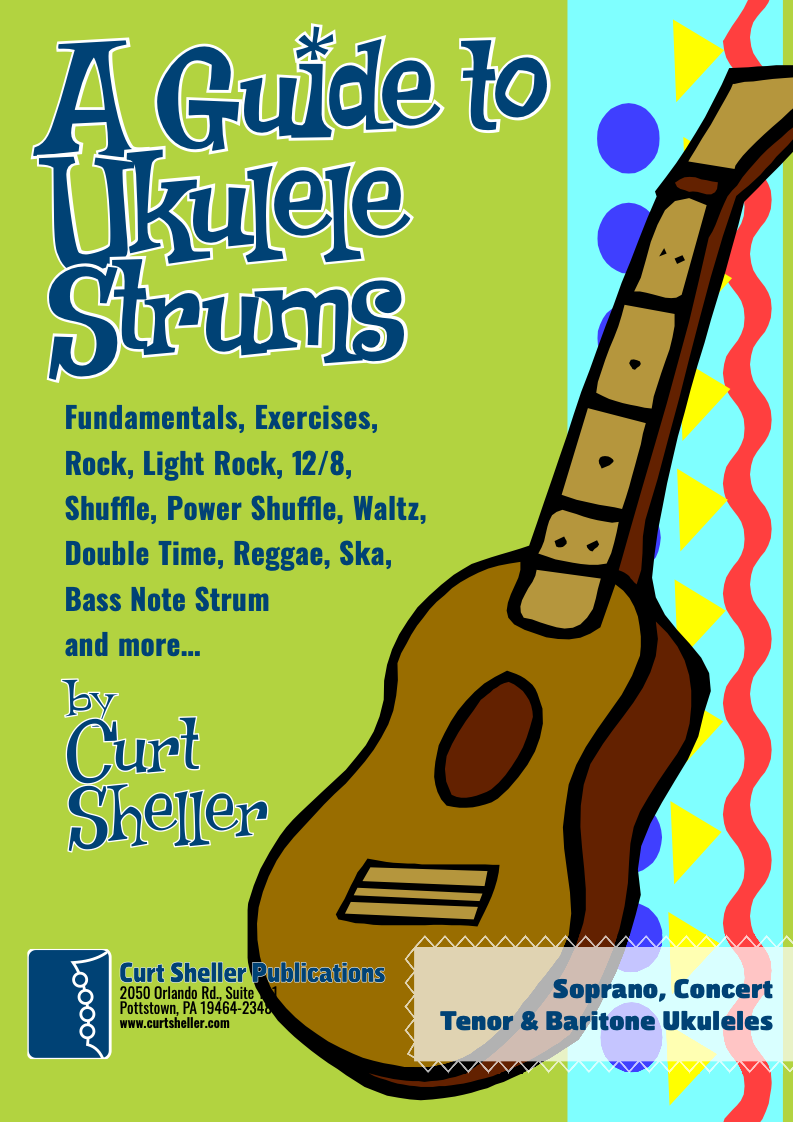
Learn a variety of strums and rhythmic patterns in wide range of musical styles. One of the first skills a ukulele player learns is the art and craft of strumming, playing rhythm. This refers to an accompaniment technique suitable for the singer, singer - songwriter or someone who plays a support role for another instrument.
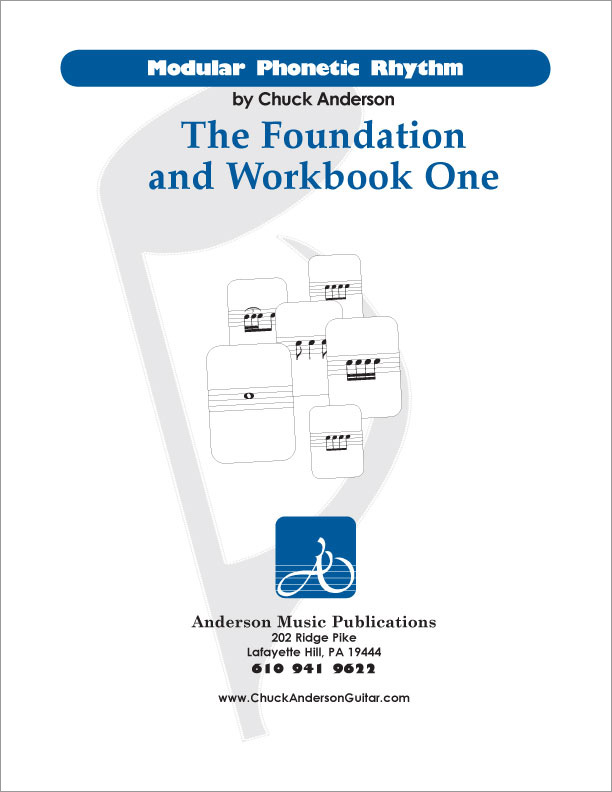
Modular Phonetic Rhythm represents a significant advance in the teaching and application of rhythm. Eliminating many inefficient aspects of rhythm education, Modular Phonetic Rhythm streamlines the traditional educational approach, resulting in a reflexive reaction to rhythm.

Finally, learn the names of the notes of the ukulele fingerboard in C tuning .

Learn the six fingering principles to navigating the ukulele fingerboard. Fingering is one of the most universal topics. Book: Six Secrets of the Ukulele Fingering

Harmonic Analysis is the understanding of the functional sequence of chords. It is the process used to analyze the harmonic structure of a progression, song or composition. Book: Harmonic Analysis for Scale Selection and Chord Substitution

Learn to read single note melodies in the first/open position is a lot easier than you might think. Book: Ukulele – Reading Music Series – Primer

An organized collection of daily practice and reference material for the contemporary ukulele player for developing the vocabulary and knowledge necessary for single note playing. Book: Daily Practice Material for the Contemporary Ukulele
Checkout the Books & Reference Charts for additional Handy, Dandy Reference Charts.

Ukulele Fingerboard Chart for C Tuning, Low or High G – G C E A

Ukulele Fingerboard Chart for G Tuning, Low or High A – D G B E

A handy reference chart of all 15 major and relative minor key signatures. US Letter 8.5 x 11 sized (ANSI-A), A4
Checkout the Books & Reference Charts for additional Handy, Dandy Reference Charts.



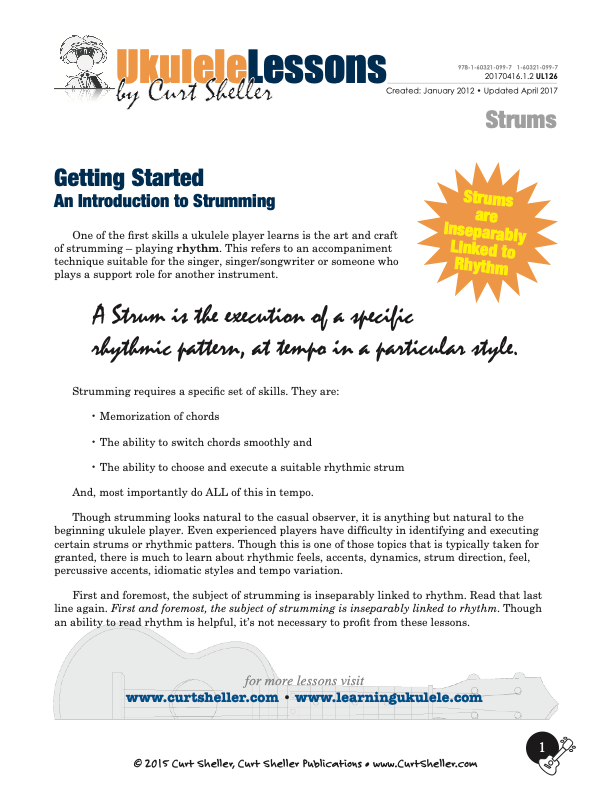
.jpg)